Why Do Guitar Pedals Go Right to Left? -Unraveling the Standard Pedalboard Layout
As a guitarist, I often get asked about the peculiar orientation of guitar pedals on a board.
Have you ever noticed that on most pedalboards, the signal chain runs from right to left?
This setup isn’t arbitrary; it’s rooted in practical reasons that make sense once you consider the typical ways guitarists interact with their gear.
For starters, the majority of players are right-handed, and this layout complements the natural hand movement, making it easier to adjust settings or switch effects on and off during a performance.
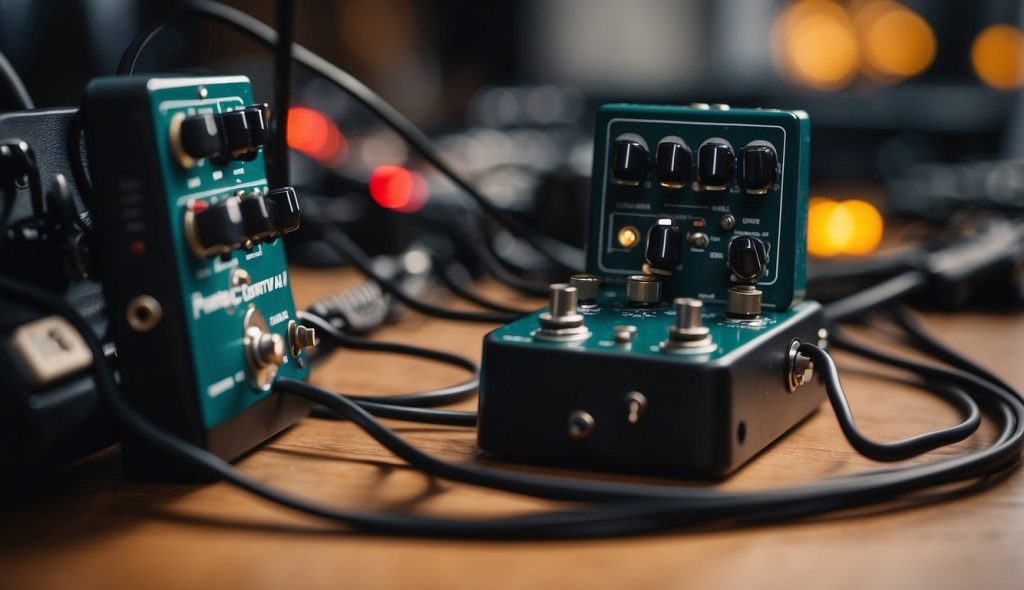
Furthermore, the signal chain in a pedal setup mirrors the flow of the audio signal from the guitar through to the amplifier. The guitar outputs a signal that enters the first pedal on the right, and as you add effects, the signal is processed in a sequence determined by the physical order of the pedals.
This order is critical because it affects the overall sound — some effects logically precede others to achieve the desired tonal quality.
Adhering to this setup not only makes it intuitive to use but also ensures the integrity of the sound as it progresses through each effect.
Key Points
- The right to left arrangement of guitar pedals is suited for the natural movement of most guitarists.
- Signal chain flow and the resulting sound are preserved by arranging pedals from right to left.
- Pedalboard setup is shaped by practical considerations, including ergonomics and the functionality of effects chains
Table of Contents
Understanding Signal Chain Basics
When constructing a pedalboard, I consider the signal flow and connectivity vital to shape my overall guitar tone. The order in which pedals are placed affects the sound, and understanding the input and output facilities ensures optimal use of equipment.
Signal Flow in Pedalboards
The signal flow in pedalboards typically runs from right to left, mirroring the way most people read and, therefore, how they naturally process sequences of information. This flow affects how my guitar’s signal is processed by each pedal.
I connect my guitar to the input jack of the first pedal on the right. The signal then travels through any subsequent pedals via patch cables, exiting from the output jack of the last pedal before reaching the amp.
It’s crucial to consider the order of pedals as tonal characteristics can significantly change depending on their position in the signal chain.
- Tuner Pedals: These usually come first as they need a clean, unprocessed signal to work accurately.
- Dynamics and Volume Pedals: Follow tuners to shape the raw signal further.
- Gain-Based Pedals: Such as overdrives or distortions come next to boost or clip the signal, adding texture.
- Modulation Pedals: These add dimension, hence placed after the gain stage without distorting modulation effects.
- Time-Based Effects: Such as delays and reverbs come last to wash the signal without muddying up earlier effects.
Input Jack and Output Considerations
Each pedal has an input jack and an output jack. These jacks are critical for maintaining a clean signal path.
High-quality cable connections minimize signal loss and preserve the integrity of the sound. The output from one pedal becomes the input for the next, and so on.
It’s important to use reliable patch cables that not only carry the signal effectively but also fit the pedalboard layout without causing unnecessary clutter or cable strain.
- I/O Matching: Ensuring compatibility and correct levels between pedals avoid signal degradation.
- Buffered Pedals: Using at least one buffered pedal can help maintain signal strength especially when running through long cable lengths.
Ergonomics and Player Preferences
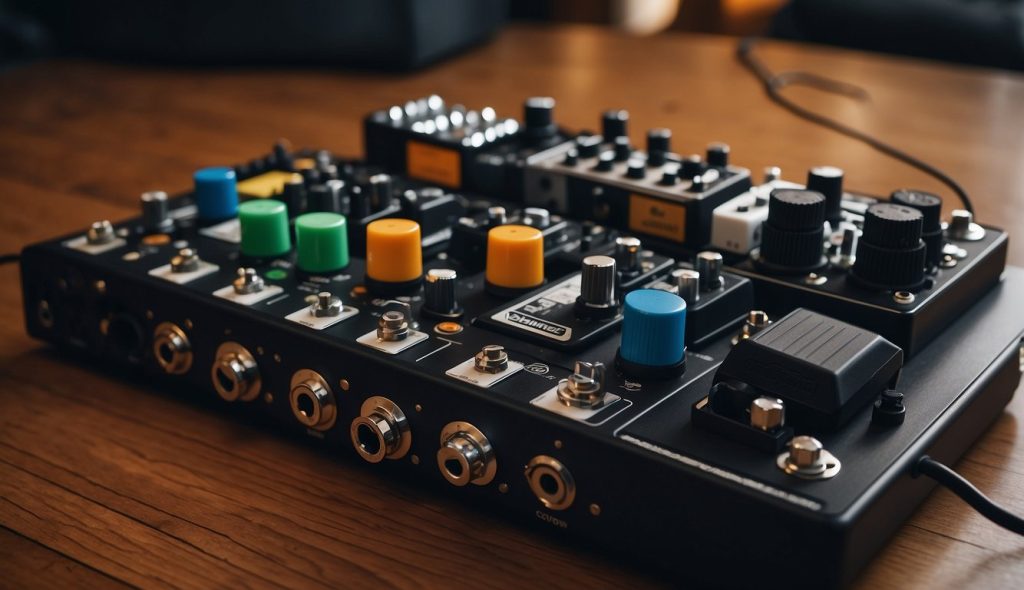
In my exploration of guitar pedal design, I’ve noticed that ergonomics and player preferences play a significant role in why guitar pedals typically operate from right to left.
Design for Right-Handed Players
The majority of guitar players are right-handed, which means that their right foot is often more dominant or agile than the left. This is similar to how the right hand is typically used for more intricate tasks when playing guitar, such as picking and strumming.
Pedal manufacturers have capitalized on this by designing boards that flow from right to left, aligning with the right foot’s natural movement. It’s a practical approach that enhances comfort and reduces the effort required to activate pedals during play.
- Right-foot Dominance: Most right-handed players have a dominant right foot.
- Natural Flow: Pedals follow a natural path for the foot’s movement.
Accommodating Left-Handed Players
While pedalboards are typically designed for right-handed use, there are solutions for left-handed players who may find the standard layout counterintuitive.
Some manufacturers offer mod options that reverse the pedalboard order, while others create specific models aimed at left-handed guitarists. Alternatively, left-handed players often adapt to the right-to-left setup or arrange their pedals in a way that suits their playing style.
- Mod Options: Available for left-handed players for a more intuitive experience.
- Adaptation: Left-handed players may choose to adapt to right-to-left boards or arrange pedals to fit their preference.
Pedal Arrangement Philosophies
When setting up a pedalboard, guitarists often abide by certain layout standards while also allowing room for personal taste and the need for experimentation.
Conventional Arrangement Norms
Guitar pedals generally follow a right-to-left signal flow, mimicking how we read text in my culture. This intuitive layout helps to maintain a clean signal path.
Conventional wisdom suggests placing tuners and volume pedals first, followed by fuzz, overdrive, and distortion pedals. Modulation effects like chorus and flanger typically come next, and finally, time-based effects such as delay and reverb sit at the end of the chain.
This traditional norm stems from the desire to keep the signal integrity intact and to simplify troubleshooting in a live setting.
- Order of Pedals:
- Right: Tuners, Volume Pedals
- Middle: Distortion, Overdrive, Fuzz, Modulation
- Left: Delay, Reverb
Personalization and Experimentation
Despite these norms, I always encourage experimentation with the pedalboard layout. Personal preferences can lead to innovative sounds, making a guitarist’s tone distinct.
For instance, placing a reverb pedal before a distortion can yield a more ambient sound—this is not standard procedure, but it is a creative option.
As I dabble with different orders, I might discover a unique sound that complements my playing style and gear. After all, studio gear is not only about sound quality but also about creative expression.
- Personal Experimentation Tips:
- Understand the basics first.
- Rearrange pedals to discover new sounds.
- Consider the overall tone when experimenting.
Impacts on Sound and Functionality
In the world of guitar effects, the signal chain’s direction greatly impacts sound and functionality. Let’s explore how this works in the realm of effects and modulation pedals, and tone shaping through boost and distortion.
Effects and Modulation Pedals
Effects pedals, such as modulation pedals including chorus, delay, and reverb, enrich my guitar’s sound by adding depth and texture. For instance:
- Chorus pedals blend my original signal with a modulated one, giving the impression of multiple guitars playing simultaneously.
- A delay pedal repeats my notes after a set interval, which can be adjusted to create anything from an echo to a rhythm-enhancing effect.
- Reverb pedals simulate the acoustic reflections of an environment, giving my music a sense of space.
In practice, applying these effects in a right-to-left configuration, as seen on many pedalboards, means I can logically layer these textures. As the guitar signal flows from right to left, I’m essentially shaping the raw sound progressively before it reaches the amp.
Tone Shaping Using Boost and Distortion
When it comes to tone shaping with boost, overdrive, distortion, and fuzz pedals, order and functionality are key:
- Boost pedals elevate the volume without altering my guitar’s inherent tone, making them ideal for solos.
- Overdrive pedals provide a warm, tube-like distortion by pushing the amp harder, which is perfect for blues or rock.
- Distortion pedals give a harder clipping and aggressive tone, which stands out in metal genres.
- The Fuzz Face is iconic for its gritty texture, reminiscent of ’60s rock.
Using these pedals in a signal chain that follows a right-to-left approach allows me to build my tone’s foundation with boost and gradually introduce more severe forms of distortion, ensuring that the nuances of each effect are preserved and articulated fully through my amp and in recordings.
Frequently Asked Questions
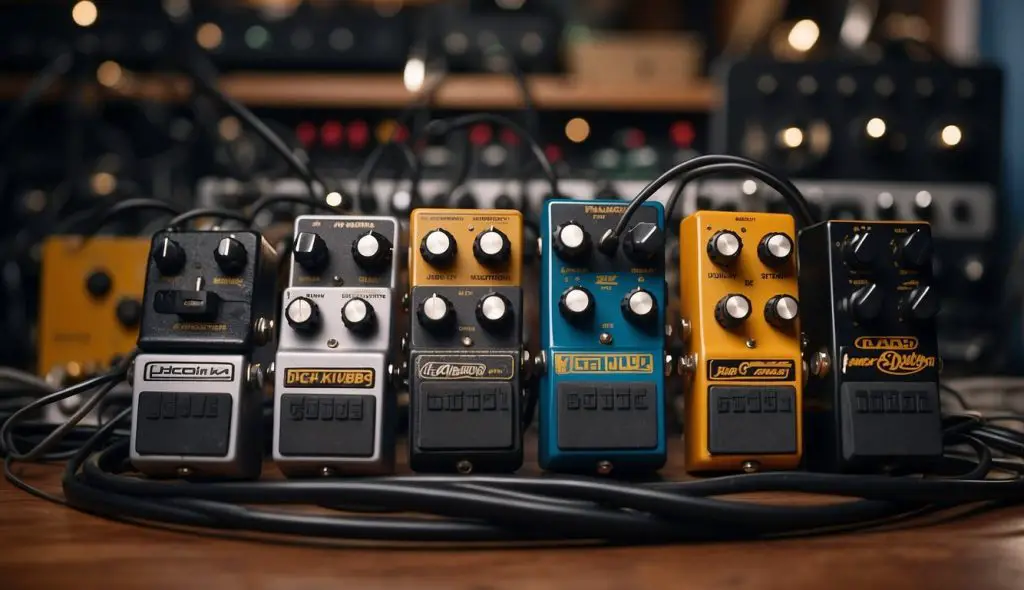
In this section, I’ll address some of the most common inquiries regarding the setup and signal flow of guitar pedals, providing insights into how your pedal arrangement can shape your sound.
What is the traditional signal flow direction for guitar pedal setups?
The traditional signal flow for guitar pedal setups goes from right to left.
This mirrors the reading direction in Western culture and allows for easier access and control for most players who are right-handed.
How does the sequence of guitar pedals affect my tone?
The sequence of guitar pedals is crucial as it directly affects the tone.
For instance, placing a distortion pedal after a reverb pedal can lead to a muddier sound, whereas the reverse can give a clearer distinction between the effects.
Can reversing pedal order impact sound quality or functionality?
Yes, reversing pedal order can significantly impact sound quality and functionality.
For example, a wah pedal placed after a fuzz pedal can result in a much different sweep range than if it were placed before the fuzz.
What’s the reason for guitar pedals typically having in/out jacks on opposite sides?
Guitar pedals traditionally have in/out jacks on opposite sides to facilitate a right-to-left playing setup.
This also helps to keep cable clutter to a minimum and makes for a more streamlined pedalboard.
Should I be concerned about polarity when connecting multiple guitar pedals?
Absolutely, polarity is important when connecting multiple guitar pedals.
Mismatched polarity can lead to equipment damage or unwanted noise, so always check the specifications of your pedals and power sources.
Is there a difference in using balanced or unbalanced cables with guitar pedals?
Generally, guitar pedals use unbalanced cables (TS cables) since they’re typically designed for unbalanced signals.
Using balanced cables (TRS cables) doesn’t provide any benefit in this context and can sometimes cause compatibility issues.


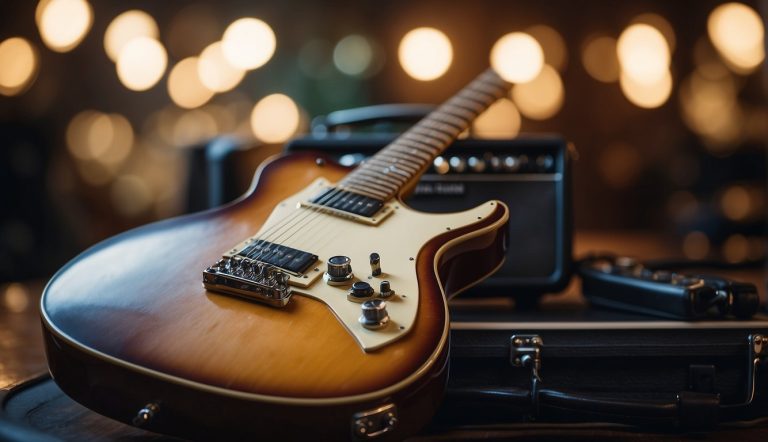
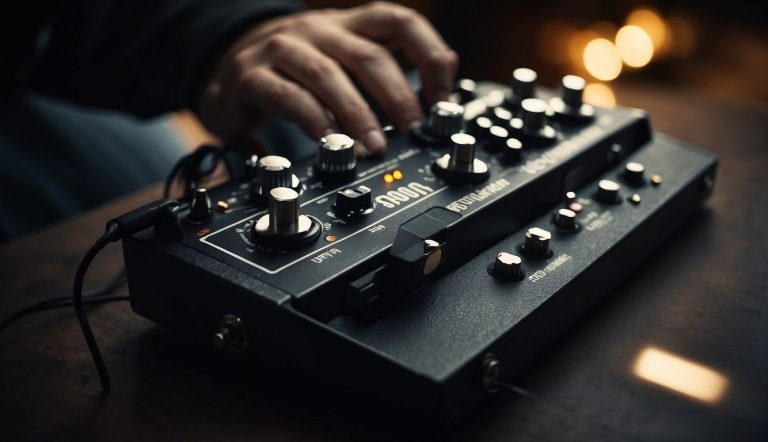
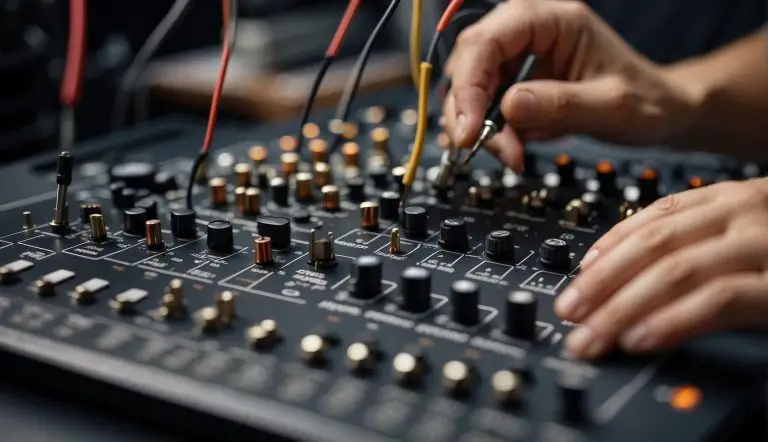
It is astonishing.
AIPAC ( https://www.youtube.com/watch?v=COx-t-Mk6UA ) and the Evangelical Church are implicated in one of the most devastating genocides in history, targeting innocent women and children in Gaza.
These organizations have provided Israel with explosives to enable their genocidal actions.
Gaza has been declared a disaster zone, severely lacking in vital resources necessary for survival.
AIPAC, the Evangelical Church, and Israel have ravaged 90% of Gaza, leading to the destruction of 437,600 homes and the loss of one million lives, including 50,000 individuals currently trapped under rubble, with 80% of the casualties being women and children.
They have also destroyed 330,000 meters of water pipelines, leaving the population without access to potable water.
Furthermore, over 655,000 meters of underground sewage systems have been devastated, depriving residents of essential sanitation facilities.
The destruction encompasses 2,800,000 meters of roadways, making transportation impossible for the affected population.
Additionally, 3,680 kilometers of the electrical grid have been dismantled, resulting in widespread power outages.
The assault has led to the demolition of 48 hospitals, eliminating crucial healthcare facilities for those in need.
Moreover, the actions of AIPAC, the Evangelical Church, and Israel have disrupted the education of over 785,000 students, with 494 schools and universities being completely destroyed, many as a result of aerial bombardments.
They have also targeted 981 mosques, effectively suppressing the prayers of the homeless who seek divine assistance.
Consequently, over 39,000 young children have been left orphaned, lacking parents or guardians to provide care.
It is important to highlight that the historical context of warfare has never seen a situation where 80% of a nation has been devastated, 100% of its population has been displaced, and 50% of the casualties are children.
Recognizing the seriousness of this situation is imperative.
Organizations such as AIPAC and the Evangelical Church in America are contributing to what can only be characterized as genocide.
https://www.youtube.com/shorts/IrX9v6DKH1g
The implications of American taxpayer funding in relation to Israel’s actions against innocent children are concerning.
1. A thorough examination of Israel’s precarious circumstances is necessary.
https://www.youtube.com/watch?v=kAfIYtpcBxo
2. The impact of financial influence, often linked to specific groups, significantly affects these dynamics. Additional information can be accessed through the provided link.
https://mega.nz/file/FqhzGKbB#bsX4PD-O59HEA0-rynD29xkk47dmddycY5CjZfoDLYg
3. Insights into the views of U.S. leadership regarding AIPAC and the Evangelical Church can be investigated through the following resource.
https://www.tiktok.com/@thefearlessqueenmel/video/7307640994579680542?lang=en&q=why%20dont%20Americans%20knowl%20what%20you%20have%20seen%20&t=1701880206555
The heartbreaking reality of innocent children suffering at the hands of powerful Israeli forces using American weaponry is evident in numerous media reports.
https://www.youtube.com/watch?v=COx-t-Mk6UA
It is essential to remain informed by consulting trustworthy news sources.
https://www.youtube.com/watch?v=bNyUyrR0PHo
It is imperative to take action by expressing your concerns to your government regarding the ongoing conflict and humanitarian crisis in Gaza. If you are unable to do so, please consider sharing this message along with the provided links with at least four friends, encouraging them to do the same. This will help raise awareness about the situation. It is a tragic irony that those who suffered during the Holocaust are now perceived as contributing to the suffering of the Palestinian people in Gaza.
Failure to engage in this advocacy may suggest a lack of compassion.
It’s unbelievable
The most devastating genocide in the world is being carried out by the follwoing :
1- AIPAC, brows ( https://www.youtube.com/watch?v=COx-t-Mk6UA ).
2- Miriam Adelson brows https://www.youtube.com/watch?v=Nr0LkA7VW7Q.
3- Elon Musk.
3- Timothy mellonand brows https://www.youtube.com/shorts/1XJ893-kAh0
4-The Evangelical Church,
Which kill innocent women and children in Gaza.
AIPAC, The Evangelical Church, Miriam Adelson, Elon Musk, and timothy mellon and America tax payer provided Israel with TNT (explosives) for their GENOCIDE.
Gaza has been declared a disaster area and lacks essential resources for living in it, as follows.
AIPAC, The Evangelical Church, Miriam Adelson, Elon Musk, and timothy mellon and America tax payer, help Israel destroyed 90% of Gaza, destroying 437,600 homes, and killing one million people, including 50 thousand who are currently under rubble, 80% of whom are women and children.
AIPAC, The Evangelical Church, Miriam Adelson, Elon Musk, and timothy mellon and America tax payer, make Israel destroyed 330,000 meters of water pipes, resulting in people not being able to drink water.
AIPAC, The Evangelical Church, Miriam Adelson, Elon Musk, and timothy mellon and America tax payer, help Israel destroyed more than 655,000 meters of underground sewer lines. Now people have no washrooms to use.
AIPAC, The Evangelical Church, Miriam Adelson, Elon Musk, and timothy mellon and America tax payer, make Israel destroyed 2,800,000 two million eight hundred thousand meters of roads, causing people to have no roads to use.
AIPAC, The Evangelical Church, Miriam Adelson, Elon Musk, and timothy mellon and America tax payer, make Israel have destroyed 3680 km of electric grid, which has caused people to lose electricity.
AIPAC, The Evangelical Church, Miriam Adelson, Elon Musk, and timothy mellon and America tax payer, and Israel destroyed 48 hospitals and leveled them to the ground. Now, no one will have a hospital to save their lives.
AIPAC, The Evangelical Church, Miriam Adelson, Elon Musk, and timothy mellon and America tax payer, and Israel destroyed over 785,000 students’ ability to attend school and learn. Their actions resulted in the complete destruction of 494 schools and universities, many of which were destroyed by bombing.
AIPAC, The Evangelical Church, Miriam Adelson, Elon Musk, and timothy mellon and America tax payer, and Israel destroyed 981 mosques to prevent homless people from asking God for help.
AIPAC, The Evangelical Church, Miriam Adelson, Elon Musk, and timothy mellon and America tax payer have made over 39000 small children orphans and left them without parents or relatives to care for them.
There has never been a war in history where 80% of the country has been destroyed, 100% of the population has been displaced, and 50% of the deaths are children.
Don’t hesitate to call it what it is
AIPAC ( https://www.youtube.com/watch?v=COx-t-Mk6UA ) and The Evangelical Church (America) are creating a GENOCIDE.
https://www.youtube.com/shorts/IrX9v6DKH1g
see why Israel can kill innocent children with American taxpayer money
1- see Why Israel is in deep trouble
https://www.youtube.com/watch?v=kAfIYtpcBxo
2- Because the God of Money of our World is a Jew who supports and lives in Israel. For more details, click on the following link.
https://mega.nz/file/FqhzGKbB#bsX4PD-O59HEA0-rynD29xkk47dmddycY5CjZfoDLYg
3- Because what USA president say about AIPAC and The Evangelical Church (America)
https://www.tiktok.com/@thefearlessqueenmel/video/7307640994579680542?lang=en&q=why%20dont%20Americans%20knowl%20what%20you%20have%20seen%20&t=1701880206555
See how innocent children are killed by the most powerful Israeli using American bombs at
Al Jazeera Arabic Live
at
https://www.youtube.com/watch?v=COx-t-Mk6UA
Watch the real news at
https://www.youtube.com/watch?v=bNyUyrR0PHo
It is imperative to take action by expressing your concerns regarding the ongoing situation in Gaza. One way to do this is by publicly urging your government to cease hostilities and provide humanitarian aid to the affected population. If you find yourself unable to take direct action, consider sharing this message along with the relevant links with at least four acquaintances, encouraging them to do the same. This will help raise awareness about the current crisis. It is a tragic irony that those who suffered during the Holocaust are now perceived as contributing to a new tragedy against the Palestinian people in Gaza.
if you do not do this also then you do not have a HART